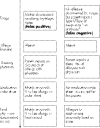Getting the data right: information accuracy in pediatric emergency medicine
- PMID: 16885256
- PMCID: PMC2564018
- DOI: 10.1136/qshc.2005.017442
Getting the data right: information accuracy in pediatric emergency medicine
Abstract
Objectives: (1) To identify the extent to which information provided by parents in the pediatric emergency department (ED) can drive the assessment and categorization of data on allergies to medications, and (2) to identify errors related to the capture and documentation of allergy data at specific process level steps during ED care.
Methods: An observational study was conducted in a pediatric ED, combining direct observation at triage, a structured verbal interview with parents to ascertain a full allergy history related to medications, and chart abstraction. A comparative standard for the allergy history was established using parents' interview responses and existing guidelines for allergy. Errors associated with ED information management of allergy data were evaluated at five steps: (1) triage assessment, (2) treating physician's discussion with parent, (3) treating nurse's discussion with parent, (4) use of an allergy bracelet, and (5) documentation of allergy history on medication order sheets.
Results: 256 parent-child dyads were observed at triage; 211/256 parents (82.4%) completed the structured verbal interview that served as the basis for the comparative standard (CS). Parents reported a total of 59 medications as possible allergies; 56 (94.9%) were categorized as allergy or not based on the CS. Twenty eight of 48 patient cases were true allergies by guideline based assessment. Sensitivity of triage for detecting true medication allergy was 74.1% (95% confidence interval (CI) 53.7 to 88.9). Specificity of triage personnel for correctly determining that no allergy existed was 93.2% (95% CI 88.5 to 96.5). Physician and nursing care had performance gaps related to medication allergy in 10-25% of cases.
Conclusions: There are significant gaps in the quality of information management regarding medication allergies in the pediatric ED.
Conflict of interest statement
Competing interests: none declared.
References
-
- Committee on Data Standards for Patient Safety Patient safety: achieving a new standard of care. Washington, DC: National Academic Press, 20041–66.
-
- Patient Safety Task Force Patient safety in the emergency department environment. American College of Emergency Physicians, 2001. Available at http://www.acep.org/download.cfm?resource = 493 (accessed 31 March 2004)

